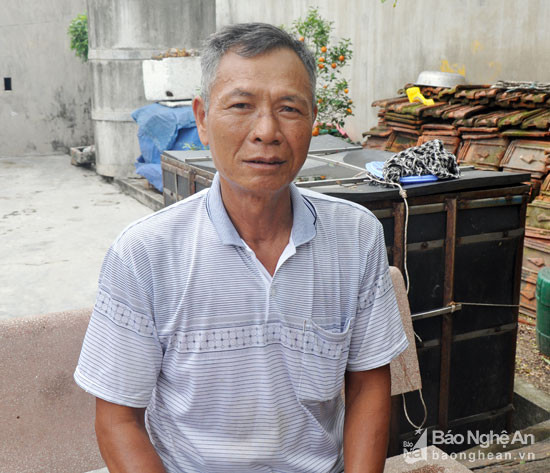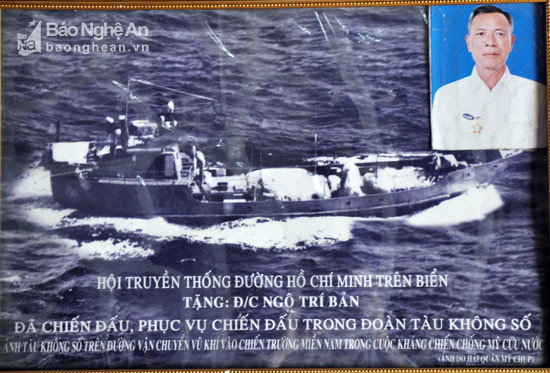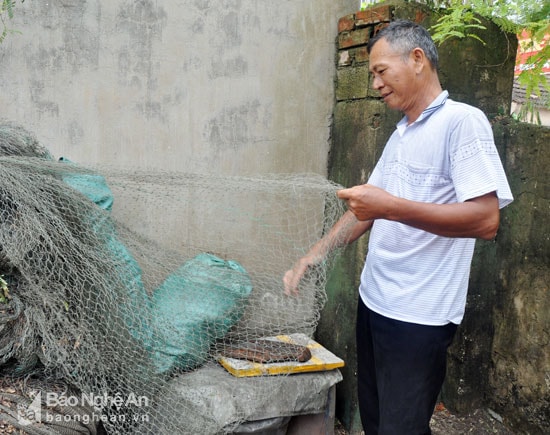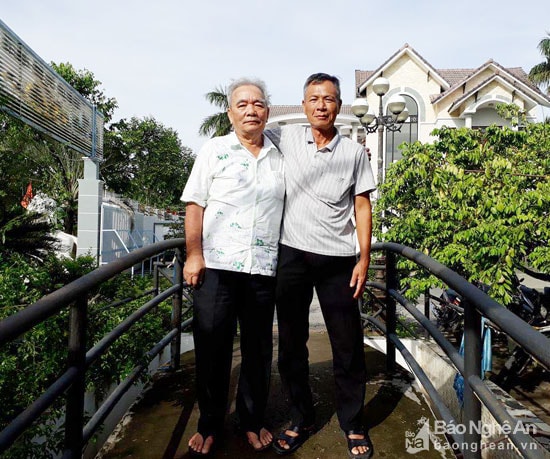Veteran of the ship without a number tells the story of eating live crabs and drinking urine to survive
(Baonghean)- With the approval of his superiors, the commander decided to scuttle the unnumbered ship himself so that the weapons would not fall into enemy hands. Mr. Ban drifted to shore, ate raw crabs, and drank his own urine to survive in the U Minh forest.
Having spent his whole life attached to the sea, Mr. Ngo Tri Ban has a 'treasure trove' of memories about the sea, especially memories of the fierce years of war, when he was a soldier on a ship without a number.
“I was born in the coastal village of Dong Loc (Dien Ngoc - Dien Chau), after finishing secondary school I followed my father to the sea to fish. Before I was 19 years old, I signed up for military service, then was assigned to the Navy, my military life was associated with ships and sea voyages...” – Mr. Ngo Tri Ban opened his memories.
In early November 1970, he boarded the Nhat Le ship with the registration number C-69B with a capacity of 200 tons and a few months later, after finishing the Lunar New Year, he received orders to transport weapons to the Southern battlefield. Before leaving, the 23 officers and soldiers of the ship were given a memorial service by the unit with an oath to sacrifice themselves rather than let the weapons fall into the hands of the enemy. The C-69B ship crossed the 17th parallel, following international waters towards the South. On the way, American destroyers were always chasing, and planes were flying overhead.
 |
| Mr. Ngo Tri Ban recounts the battle of ship C-69B in Vung Tau waters in 1970. Photo: Cong Kien |
Captain Phan Xa was forced to change course to the Philippine sea, then circle to Indonesia, then Malaysia to create a diversion. The enemy pursued fiercely, the ship's commander received orders to return to the original port of departure.
Returning to the port in the North, 15 days later, the route was still as planned. Enemy warships and planes were still chasing, ship C-69B had to continuously change flags and numbers, and circle around to international waters. On April 11, while in Malaysian waters, the ship's command received orders to change course to shore, quickly reaching Ca Mau sea. When about 25 nautical miles from shore, encountering enemy patrol ships, ship C-69B still increased speed. The enemy sent a signal, we did not respond. The red signal was sent from the enemy ship, we still did not respond.
When about 10 nautical miles from shore, the enemy opened fire. The ship commander reported to his superiors and asked to execute plan 2, which was to open fire in return. The C-69B was surrounded and threatened by 7-8 destroyers continuously firing mortars. A moment later, a group of planes appeared and fired rockets like rain. On one hand, they had to maneuver to avoid the enemy, on the other hand, they had to fight against the enemy. All positions on the ship were ready to sacrifice to complete the mission.
 |
| The photo of the ship without a number is carefully kept by Mr. Ngo Tri Ban. Documentary photo |
Soldier Ngo Tri Ban was assigned to load artillery shells, the gunner died, he loaded shells and fired the cannon at the same time. The battle was unequal, ship C-69B was hit in the cockpit, the engine was severely damaged, the ship drifted freely, the Deputy Captain and 4 soldiers died. Captain Phan Xa asked his superiors to execute plan 3, which was to destroy the ship, not letting weapons and goods fall into enemy hands. With the superiors' approval, the Captain ordered the bodies of the 5 dead to be put in death bags to be brought ashore, the remaining people prepared to leave the ship.
At that moment, 4.8 tons of explosives on the ship were ignited, the time set for detonation was 45 minutes. Mr. Ban left the ship with an AK with a folding stock, 5 magazines of ammunition, a life jacket, and struggled in the dark of the night in the middle of the ocean. About 500 meters away from the ship, a terrifying explosion sounded, his body seemed to be lifted into the air and thrown into the sea, the ship became a giant fire and a column of smoke rose several kilometers high. Dizzy from the pressure of the explosion, Mr. Ban tried to regain his composure and continued swimming to shore...
 |
| Mr. Ngo Tri Ban helps his children and grandchildren fix the net before going out to sea to fish. Photo: Cong Kien |
The rolling waves pushed Ngo Tri Ban into a swamp. He used all his strength to hug a mangrove tree to avoid being swept away by the waves, then crawled step by step in the mud. As soon as it was light, the enemy used helicopters to circle and landed two battalions to hunt down the soldiers of the C-69B. He had to take off all his uniform, smear mud all over his body, and lie close to the mangrove tree. In the evening, when the enemy withdrew, he continued to stand up and go deeper into the mangrove forest, walking for 3 days and 3 nights.
Mosquitoes from the U Minh Ha forest swarmed all over his body like a swarm of bees in a nest. At night, he had to dig a hole in the mud, covering his entire body except for his head to avoid mosquitoes. After several days without food, his whole body was exhausted. He had to catch crabs to eat raw to have the strength to continue going deeper into the forest. Then came the turn of thirst, in the middle of the mangrove forest, he had to reluctantly use his hands to collect his urine to drink, fighting the terrible thirst. On the last night in the mangrove forest, his strength was exhausted, Mr. Ban saw a faint oil lamp in the distance.
 |
| Mr. Ngo Tri Ban reunited with his old comrades in Can Tho. Photo provided by family |
Coming closer, a small hut appeared, inside there were 6 people wearing black pajamas and checkered scarves lying on 6 small platforms. Surely this was a revolutionary base, he knocked on the wall, and after exchanging the password, he fainted. When he woke up the next morning, Mr. Ban found himself washed clean, wearing black pajamas, and learned that this hut was the shelter of a secret team of Military Region 9. After finishing his breakfast porridge, he felt much better, and was picked up to return to the base of the liberation army around noon.
At that time, the enemy tightly controlled the sea routes, ships without numbers could not dock at Ca Mau sea, soldier Ngo Tri Ban had no way to return to his old unit so he joined the liberation force of Military Region 9, participating in the fight until the day of complete liberation of the South.
Mr. Ban confided: “To be able to survive and return to my family and homeland is a blessing and a happiness, because so many comrades have buried themselves under the sea or remained in the mud of the cape. Whenever I feel well, I often go to visit my comrades and revisit the old battlefields...”.
Cong Kien
| RELATED NEWS |
|---|

